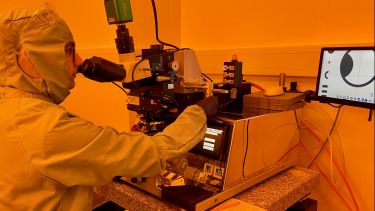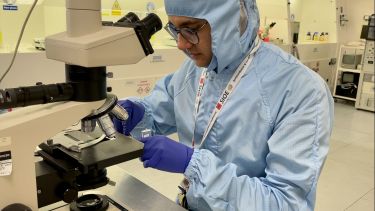A new paper, 'Extremely low excess noise avalanche photodiode with GaAsSb absorption region and AlGaAsSb avalanche region', was published online on the 31 January 2023 by the Applied Physics Letters journal. The article was published open access and can be read here. The editors at Applied Physics Letters also selected the article to be featured on the journal's homepage due to its high quality.
Optical pulses, which appear as a flash of light, are used to transmit information in high speed optical fibres, and are increasingly used in Light Detection And Ranging (LIDAR) for 3-dimensional imaging. Both of these applications demand light sensors or photodiodes that are capable of detecting very low levels of light intensity down to a few photons, where a single photon is the quantised energy unit of light.
The newly published paper details the research team's discovery, which has the capability to transform a single electron at its input, to a cascade of electrons at its output. This multiplication process is commonly known as avalanche breakdown, while a photodiode incorporating this process is called avalanche photodiode (APD). Though the application of reverse voltage, avalanche photodiodes (often referred to as APDs) have internal gain, which means that when compared to PIN-photodiodes they typically have a higher signal-to-noise ratio.
However, the team's newly designed photodiode exhibits high multiplication factor with very little added noise. The measured noise factor at a multiplication factor of 20 is at least three times lower than a commercial avalanche photodiode. Less noise in this context means that there is less interference in the recognition of signals, and the photodiode is therefore more useful due to increased sensitivity.
In the published paper, the team of researchers from the Department of Electronic and Electrical Engineering, led by Head of Department Professor Chee Hing Tan, demonstrated that they can combine a new semiconductor alloy with a wider bandgap semiconductor AlGaAsSb multiplication region. The new semiconductor alloy is based on a GaAsSb absorption region that has excellent detection efficiency at infrared wavelengths (up to 1700 nanometres).
This research is a major breakthrough in infrared APD as commercial APDs based on InP have reached their limits since the 1990s. The team led by Prof. Tan, first introduced AlGaAsSb based APDs and showed their low noise performance in 2012 and has since continuously improved the performance using a number of designs. The wafers were grown by the EPSRC National Epitaxy Facility at Sheffield.
In this work, the wafers were transformed into devices by Tarick Blain while Ye Cao performed the measurements and modelling. Additional support in modelling, measurements and analysis were contributed by Jonathan Taylor Mew, Longyan Li and Jo Shien Ng, illustrating the importance of crucial contribution of effective teamwork to the research carried out in the Department of Electronic and Electrical Engineering at the University of Sheffield.
Speaking about the research and the publication of this ground-breaking article in the field of infrared avalanche photodiodes, Professor Chee Hing Tan said:
One of the longstanding limitations of infrared APDs is a relatively high added noise from the multiplication process that limits the maximum multiplication factor. This in turn prevented infrared APDs from reaching the performance limit predicted by established models. Our breakthrough result, with an excess noise factor of 2.48, is approaching the theoretical lower limit of 2. This provides the pathway to realise extremely low noise APD that I believe can generate step changes in optical communication and long range LIDAR.
Professor Chee Hing Tan
Head of the Department of Electronic and Electrical Engineering and lead author on the published paper




